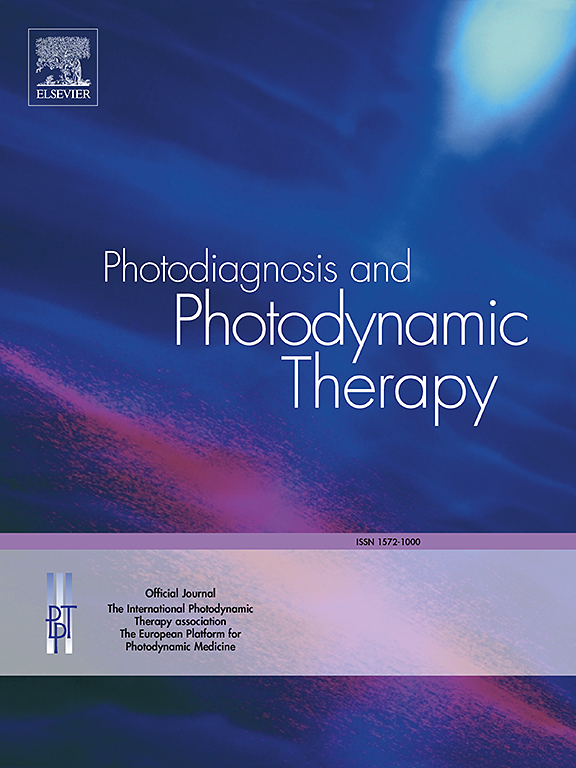Assessment of systemic reaction to inflammation induced by photodynamic therapy in cervical intraepithelial neoplasia
IF 3.1
3区 医学
Q2 ONCOLOGY
引用次数: 0
Abstract
Photodynamic therapy is a curative treatment of human papillomavirus-associated diseases that provides a selective effect leading to the destruction of pathological cells containing the virus. The retrospective study aimed to determine the role of systemic inflammatory reaction induced by photodynamic stimulation in low- and high-squamous intraepithelial lesion treatment.
Methods
143 patients with confirmed human papillomavirus-associated cervical intraepithelial neoplasia underwent photodynamic therapy with Photolon and activation in the range of 662 nm. All patients underwent colposcopy, histologic study, HPV DNA analysis, CBC, and immunogram. The chi-square criterion was used to evaluate differences before, 5 days post, and 3 months after PDT; a P value <0.05 was considered significant.
Results
A complete regression in patients with low-squamous intraepithelial lesion (n=117) was achieved 3 months after PDT in 89.7% of cases (105/117) while it persisted in 12 patients. Complete regression in patients with high-squamous intraepithelial lesion (n=26) was achieved in 92.3% (24/26), one patient retained with the lesion, and another one had partial regression in the form of lower grade lesion. On the 5th day post-PDT, the formation of dense fibrin in photodynamic effect was noted on colposcopy, and changes in CBC, accompanied by statistically significant neutrocytosis, increased ESR and other indicators of reactive inflammation were recorded. Patients noted increased body temperature up to 37.8±0.5°C in 88% of cases.
Conclusion
One of the mechanisms of PDT`s antitumor and antiviral action is the development of acute inflammation in response to cytotoxic action on cells and vascular response in the form of pathological area devascularization. Such reactive inflammation activates all parts of the immune system. Changes on day 5 post-PDT in inflammatory parameters in CBC and IL-1, IL-6 and TNF-α markers correlate with the clinical picture of the post-photodynamic effect.
评估光动力疗法在宫颈上皮内瘤变中诱发炎症的全身反应。
光动力疗法是一种治疗人类乳头状瘤病毒相关疾病的方法,它具有选择性作用,可破坏含有病毒的病理细胞。这项回顾性研究旨在确定光动力刺激诱发的全身炎症反应在低度和高度鳞状上皮内病变治疗中的作用。方法:143 名确诊为人乳头瘤病毒相关宫颈上皮内瘤变的患者接受了 Photolon 光动力疗法,激活波长范围为 662 纳米。所有患者都接受了阴道镜检查、组织学研究、HPV DNA 分析、全血细胞计数和免疫图谱检查。采用卡方检验标准评估光疗前、光疗后 5 天和光疗后 3 个月的差异,P 值为 0:89.7%的低鳞状上皮内病变患者(n=117)在 PDT 3 个月后实现了完全消退(105/117),12 例患者的病变持续存在。92.3%(24/26)的高鳞状上皮内病变患者(n=26)的病灶完全消退,一名患者的病灶仍然存在,另一名患者的部分消退表现为低级别病灶。光动力疗法后第 5 天,阴道镜检查发现光动力作用下形成致密纤维蛋白,记录到全血细胞计数发生变化,伴有统计学意义上的中性粒细胞增多、血沉增快和其他反应性炎症指标。88%的患者体温升高至 37.8±0.5°C:PDT抗肿瘤和抗病毒作用的机制之一是细胞毒性作用和病理区域血管脱落形式的血管反应引起的急性炎症。这种反应性炎症激活了免疫系统的各个部分。光动力疗法后第 5 天,血细胞计数中的炎症参数以及 IL-1、IL-6 和 TNF-α 标记的变化与光动力疗法后效应的临床表现相关。
本文章由计算机程序翻译,如有差异,请以英文原文为准。
求助全文
约1分钟内获得全文
求助全文
来源期刊

Photodiagnosis and Photodynamic Therapy
ONCOLOGY-
CiteScore
5.80
自引率
24.20%
发文量
509
审稿时长
50 days
期刊介绍:
Photodiagnosis and Photodynamic Therapy is an international journal for the dissemination of scientific knowledge and clinical developments of Photodiagnosis and Photodynamic Therapy in all medical specialties. The journal publishes original articles, review articles, case presentations, "how-to-do-it" articles, Letters to the Editor, short communications and relevant images with short descriptions. All submitted material is subject to a strict peer-review process.
 求助内容:
求助内容: 应助结果提醒方式:
应助结果提醒方式:


